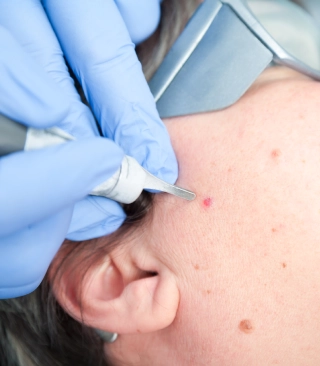If you have a mole on your face or body that you want removed, know that you’re not alone and you have plenty of options for dealing with it.
Moles are so common that almost all of us have them,16 to 40 per person, to be exact. They are nothing more than clusters of melanocytes (pigment causing cells), and they come in many shapes, sizes, and colors. Almost all of them are harmless.
That being said, some of them aren’t, and it’s important to have any suspicious moles checked by a dermatologist. Examine your moles for irregular borders, changes in color or size, and asymmetry. It’s always better to ask your doctor if you have doubts about a mole.


9015 Mountain Ridge Drive, Suite 200,
Austin, TX 78759
Once you and your doctor agree that it’s time to remove your mole, it’s time for you to decide how you want to approach it.
The most common mole removal techniques are as follows…
Each option has its pros and cons. Efficacy and chance of scarring are important things to consider.
Freezing is used on small, non-cancerous moles using a small amount of liquid nitrogen. It is also known as cryotherapy. This is only used for moles that are on the surface of the skin and is not an appropriate treatment for deeper moles.
After treatment you can expect to have a small blister where the mole was for a few days before it flattens. Although chances are low, mole freezing does come with a small risk of developing a white scar after healing.
In this method moles are burned off (aka cauterized) by using a heated wire or a laser. Again, this is used only when the mole is sitting on the surface of your skin. After treatment you will develop a scab that will fall off in a week or two, leaving behind an area of fresh, pink skin.
This should fade to normal skin color over time. With proper aftercare, there is a low chance of scarring with this method.
It’s important to note that moles that are frozen or burned off have a greater risk of recurring than other methods of removal. Because these are more surface procedures, sometimes not all of the mole cells are destroyed, and the mole can then grow back.
For larger and deeper moles, your doctor might want to shave it. Sometimes this option will be chosen if your doctor wants to send a tissue sample to the lab for further assessment or simply because the mole is large and needs to be debulked for easier removal.
After the mole is shaved down using a sharp scalpel, the area will be cauterized to stop any bleeding and to help form a scab. Because the skin is cut and cauterized at a relatively deep level, your chances of scarring increase. You might end up with a small, depressed white scar.
There are a few different modes of mole removal using excision. They are reserved for the deepest moles.
The first is simple excision, where your doctor will cut out the mole as well as a small amount of surrounding tissue to make sure all the mole cells are removed. Stitches may be needed.
The second is punch excision, where your doctor uses a tool to remove deeply rooted moles that are less than 8mm in diameter. Stitches will possibly be used to close the wound.
For excisions, healing time is increased, as is risk of scarring. Healing may take anywhere from a few weeks to several months, depending on the size and depth of the mole.
Shaving and excision have an extremely low chance of mole recurrence due to the more aggressive nature of the treatments.
With any procedure there is a risk of scarring. Proper aftercare can greatly minimize the likelihood of bad healing outcomes. No matter how your mole is removed, follow your doctor’s aftercare recommendations.
Keep the area clean, moist, and covered as directed. Try not to stretch or pull on the skin. Stay out of the sun and use sunscreen on the area when your doctor says you are able to. Be gentle and patient with your healing and alert your doctor of any pain, redness, or swelling during recovery.
If you do end up with scarring, you may be able to minimize the appearance with the use of microneedling, lasers, or other treatments your dermatologist might recommend. If you are prone to keloids, steroid shots and silicone sheets can help to flatten the scar.
Moles are a common annoyance that you don’t have to live with. Insurance will usually cover the cost if there is a medical reason for the mole removal. If it’s purely cosmetic, you may need to pay out of pocket. Prices vary greatly depending on the size of the mole and the complexity of the procedure, so be sure to discuss cost with your provider beforehand.
With several treatment options and a low risk of complications, mole removal is a good choice for many people. Discuss your options with your dermatologist and decide if mole removal is the right decision for you.

© 2023 Nature of Skin